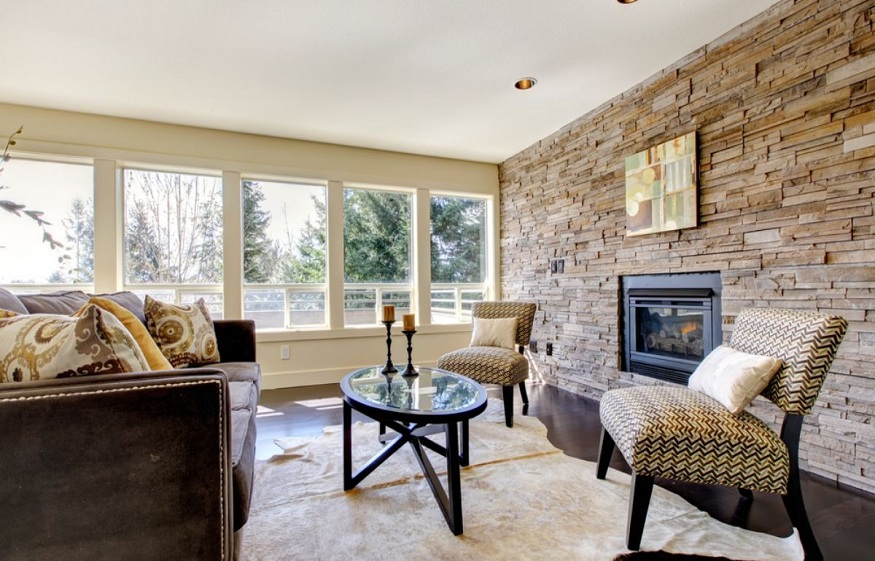In addition to being functional, the walls of a house or apartment must show the owners’owners’ personality. And there are different types of floor and wall coverings! In this article, we will review the characteristics and possibilities of the use of 7 exterior cladding and interior cladding materials.
Porcelain tile, a resistant exterior coating
Porcelain tile is most used materials for exterior and interior cladding since:
- The porosity of porcelain tiles is minimal, which helps reduce water absorption —in rainy seasons, it will be very helpful to have this exterior coating for houses—.
- It is a material resistant to sudden temperature changes and cleaning products.
- It is hard and shock resistant. For this reason, it is often used in patios where children play, in high-traffic areas and garages, and not only as wall cladding, because we also see porcelain floors!
- It offers durability without sacrificing aesthetics since you find decorated porcelain tiles that give category to any house.
- You can achieve an effect of continuity in your spaces with rectified porcelain tiles.
However, one point you should consider is that porcelain tile is usually quite cold, so it can create a cooler microclimate inside a house or apartment if used as interior cladding.
Ceramics, versatility for walls and floors
Along with porcelain tile, ceramic is one of the most widely used wall coverings. Versatility is one of its main advantages since you find multiple designs and models to give each housing space a different personality.
The different types of ceramics do not require much maintenance and do not trap odours. However, they are resistant and practical. For this reason, any of them is suitable for being placed in different spaces as exterior or interior cladding for houses.
However, among its disadvantages, it is a cold material, and its durability depends on its quality. Therefore, you should buy them at a trusted specialized store that provides the best materials for your construction project.
Polished micro cement, ideal for industrial atmospheres
Microcement is a paste made with cement, resins, additives and mineral pigments. Its main feature is that it has no joints, providing a greater sense of spaciousness. It is versatile and can be used in any interior design project, such as exterior and interior cladding.
It is a material that favours rustic and industrial finishes. You usually find it in neutral tones, which offers balance when combined with other elements such as wood, glass or natural fibres.
Microcement is a type of coating that does not require much maintenance. However, it requires specialized installation. An alternative that is easier to install to achieve the same effect is concrete-type porcelain tiles that provide a sense of continuity and balance to environments.
Natural stone, a durable exterior cladding
Natural stone is the most used exterior cladding, found in many designs and colours. Its rough texture adds a rustic touch to the environment and is perfect for dividing rooms in houses of a few meters.
You can also use “stone-type” porcelain tiles with which you will have the same effect but with much less maintenance.
A trend on the rise is using stone as interior wall cladding. And it is that properly combined with other elements such as floors or decoration, and it can provide an elegant, sophisticated and original touch to spaces.
If you decide to use it as an interior cladding for houses, the recommendation is to place the stone only on one wall. Otherwise, excessive use can make the environment look stuffy and heavy.
Also, remember that this wallcovering type tends to create a cold environment and can reduce the space.
Mosaics are perfect for covering humid environments
Mosaics —also known as tiles or tiles— are a type of wall covering ideal for interiors, especially to remodel the bathroom or kitchen in humid environments.
The reason for this is twofold. On the one hand, it is a material that does not stain and is very easy to clean. And on the other hand, it offers high durability regardless of its type: glass, stone, marble, ceramic or aluminium.
In addition to using bathroom tiles, some architects and designers use mosaics to add character to a particular space. For example, these types of interior cladding can be installed in corridors, columns and dining rooms. Nor is it ruled out as exterior cladding on terraces and patios.
Remember that, like stone, mosaic tiles can be cool to the touch. In addition, it requires careful and professional installation, as it offers almost infinite possibilities to create different combinations and effects in wall decoration that can be less aesthetic in unprofessional hands.
Wall cladding, an aesthetic exterior cladding
Wall cladding —or decorative brick— is one of the traditional types of exterior cladding that has been used lately as interior cladding for houses.
The facades provide texture, relief, volume and colour to the walls. And not only do they shine to rescue the aesthetics of brick, but they also help protect the walls from dirt or weather conditions.
You can find wall cladding with different colour ranges and textures, depending on what you want to implement in your construction project: some thicker ones that favour an industrial style and others that are smoother, sober and smaller, creating an elegant atmosphere.
Wall cladding gives a very aesthetic touch to any home. In addition, it is an easier material to install compared to stone, for example. However, if you use it as exterior cladding, it is better to put it through a waterproofing process so that it lasts much longer.
Wood, warmth for your spaces
Both wood and panels that imitate it are other types of exterior cladding. Some people prefer this material for the naturalness and comfort that it conveys, which is why it is mainly used in bedrooms.
Unlike other types of wall cladding we have seen, natural wood brings warmth to an environment: it is a very versatile thermal and acoustic insulator that, of course, can be used as exterior cladding with proper maintenance.
That is, it is a big “but”: cost and maintenance. Wood requires certain care to avoid premature deterioration caused by humidity, sun or insects. Another disadvantage is that wood comes in predetermined shapes and sizes, leading to more work during installation.
This is why “wood effect” porcelain tiles are an excellent alternative to natural wood; they incorporate the aesthetics of wood but do not need the maintenance that this material requires.
What type of exterior or interior cladding to choose?
Now that you know the characteristics of the main exterior wall cladding materials and those that you can use for the interior of a house, apartment or office, the question is: which one to choose?
There are several aspects that you must take into account:
- The hardness. You need more resistant materials for exterior cladding, while you can be a little more flexible with interior cladding.
- The texture. Do you want a smooth, glossy, opaque, semi-matte or matte finish? As a rule, the shinier it is, the easier it will be to clean.

